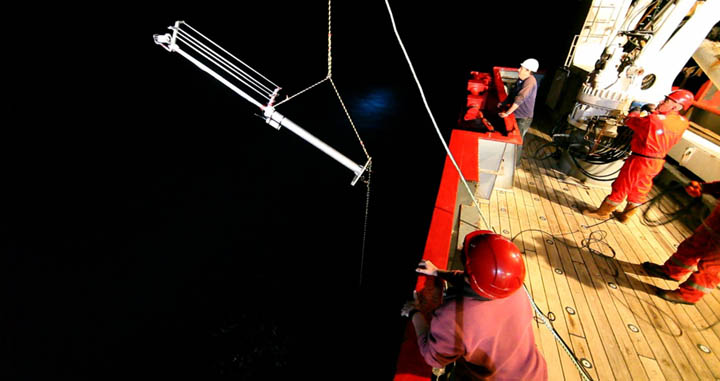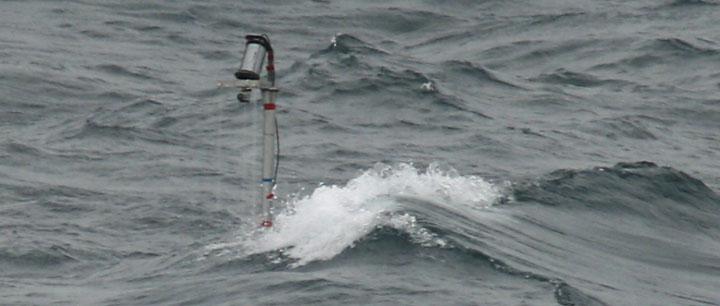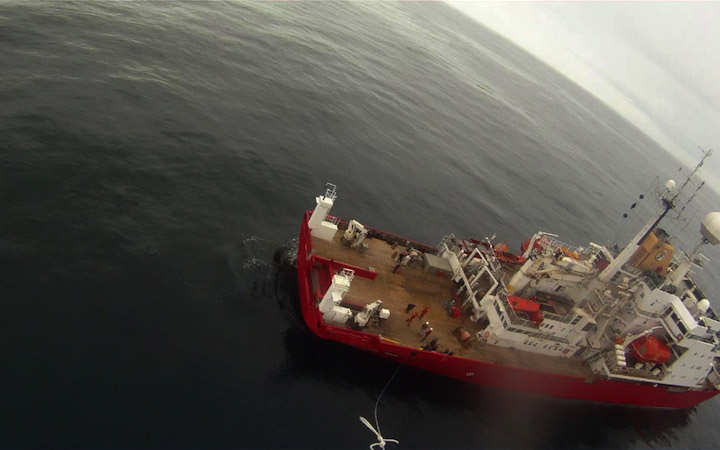
Above - the spar buoy is deployed for the first time late on the evening of May 27 for a brief test. Everything worked well.
WAVES, AEROSOLS AND GAS EXCHANGE STUDY (WAGES)
Oceans cover about 70% of the Earth's surface; physical exchanges between the atmosphere and ocean have a major impact both on weather systems and on global climate. The oceans are thought to have absorbed approximately 30-50% of the carbon dioxide (CO2) generated from the burning of fossil fuels. The rate of exchange varies in response to enivoronmental conditions such as wind speed and wave state but is not well understood, particularly at high wind speed where there are few direct measurements. The same processes that affect air-sea gas exchange also control the production of sea-spray aerosols; these are an important source of cloud condensation nuclei (CCN) - the seeds upon which cloud droplets grow - and also important to some atmospheric chemistry.
The WAGES project aims to improve our understanding of the impact of waves on the exchange of CO2 at the air-sea interface, and on the generation of sea-spray aerosol. We will conduct a 2-year programme of continues air-sea flux measurements on the research ship the James Clark Ross (operated by the British Antarctic Survey).
WAGES News
November 2011 - Sarah is about to head off to join the James Clark Ross again, with Margaret and Robin from NOC. As before the team will be maintaining a fieldwork blog.
Weather forecast: www.stormsurf.com/mdls/menu_wx.html
Wave conditions: www.oceanweather.com/data/
The AutoFlux instrumentation was installed on the JCR in late May 2010 by Robin Pascal and Margaret Yelland and is undergoing a shake-down test during the PAPS mooring deployment cruise. Also being tested is a new spar buoy fitted with wave wires to make detailed measurements of the surface wave spectra. Later this year we will fit a commercial wave radar system to the JCR, along with digital cameras to obtain imagery for the determination of the extent of whitecaps formed by breaking waves. The bubbles generated by wave breaking are thought to enhance the rate of gas transfer, and bursting of the bubbles at the surface generates sea-salt aerosol.

Above - the spar buoy is deployed for the first time late on the evening of
May 27 for a brief test. Everything worked well.
May 30 - the spar buoy has now had 4 successful deployments of 2-5 hours each. There's a National Geographic film crew on board - they've mounted a small video camera on the spar for one deployment to get footage of the ship, and at the bottom end of the spar looking up through the water column for another deployment.
 |
|
The spar buoy is fitted with 4 sets of capacitance wave wires, visible in the image on the right - these allow the location of the water surface to determined with respect to the spar column at each pair of wires. This information will later be used to determine the wave spectrum. It is also possible to derive information about the occurence of breaking waves passing through the wires (above). The canister at the top of the buoy contains a video camera to image the area where the wave wires enter the water, this provides a valuable visual check on what was happening when we come to analyse the data. The control electronics and logging system are housed in a water-tight canister located near the bottom of the wires (visible in the image of the deployment above) |
 |
December 2010 - Our scheduled cruise got (mostly) cancelled due to mechanical problems with the aircraft that should have flown scientists out to join the JCR in Antarctica. All was not lost, however, and Margaret and Robiin managed to join the ship in Port Stanley and get several days of dedicated ship time for some WAGES science. The aerial photography balloon - from which we plan to obtain whitecap imagery over a much wider area than possible from the ship - was flown for the first time. Below is a picture of the JCR from the balloon.

The WAGES project is a collaboration between the National Oceanography Centre, Southampton (NOCS) and the University of Leeds. The NOCS team is led by Margaret Yelland and Meric Srokosz and includes Robin Pascal, Ben Moat and Christine Gommenginger; the group at Leeds consists of Sarah Norris and David Tupman, and is led by Ian Brooks. We have a number of close collaborators: Nick Hardman-Mountford of the remote sensing group at the Plymouth Marine Laboratory (PML) who maintain the pCO2 system on the JCR that provides measurements of the mean CO2 concentration in both atmosphere and ocean. Maggie Anguelova of the US Naval Research Laboratory will use our in-situ measurements to help develop satellite retrievals of whitecap fraction for use in making global estimates of sea spray production and gas transfer.
Contacts:
Ian Brooks : i.brooks@see.leeds.ac.uk
Margaret Yelland : m.yelland@noc.soton.ac.uk
 |
 |